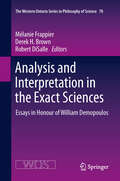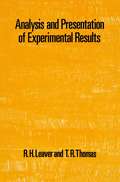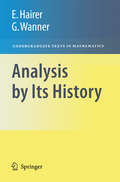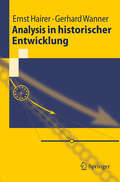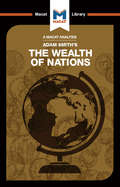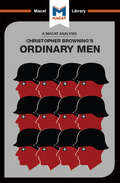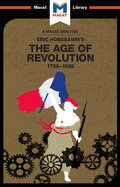- Table View
- List View
Analysing the Boundaries of the Ancient Roman Garden: (Re)Framing the Hortus (Ancient Environments)
by Victoria AustenThis book demonstrates how the Romans constructed garden boundaries specifically in order to open up or undermine the division between a number of oppositions, such as inside/outside, sacred/profane, art/nature, and real/imagined. Using case studies from across literature and material and visual culture, Victoria Austen explores the perception of individual garden sites in response to their limits, and showcases how the Romans delighted in playing with concepts of boundedness and separation. Transculturally, the garden is understood as a marked-off and cultivated space. Distinct from their surroundings, gardens are material and symbolic spaces that constitute both universal and culturally specific ways of accommodating the natural world and expressing human attitudes and values. Although we define these spaces explicitly through the notions of separation and division, in many cases we are unable to make sense of the most basic distinction between 'garden' and 'not-garden'. In response to this ambiguity, Austen interrogates the notion of the 'boundary' as an essential characteristic of the Roman garden.
Analysing the Boundaries of the Ancient Roman Garden: (Re)Framing the Hortus (Ancient Environments)
by Victoria AustenThis book demonstrates how the Romans constructed garden boundaries specifically in order to open up or undermine the division between a number of oppositions, such as inside/outside, sacred/profane, art/nature, and real/imagined. Using case studies from across literature and material and visual culture, Victoria Austen explores the perception of individual garden sites in response to their limits, and showcases how the Romans delighted in playing with concepts of boundedness and separation. Transculturally, the garden is understood as a marked-off and cultivated space. Distinct from their surroundings, gardens are material and symbolic spaces that constitute both universal and culturally specific ways of accommodating the natural world and expressing human attitudes and values. Although we define these spaces explicitly through the notions of separation and division, in many cases we are unable to make sense of the most basic distinction between 'garden' and 'not-garden'. In response to this ambiguity, Austen interrogates the notion of the 'boundary' as an essential characteristic of the Roman garden.
Analysing the Current Afghan Context
by Neeraj Singh ManhasAfghanistan is on the verge of another transition as it seeks stability and deals with a variety of internal and external issues. After the Taliban, an Islamic fundamentalist organisation, captured Kabul, Afghanistan’s capital, on August 15, 2021. It was the culmination of a military offensive against the Afghan government that began in May 2021. The arrest occurred just hours after President Ashraf Ghani fled the country. The majority of Afghanistan’s provincial capitals had fallen one after the other as part of a US troop withdrawal scheduled to end on August 31, 2021. Internal political turmoil, constant Taliban attacks across the country, and deadly suicide bombings by the Islamic State-Khorasan keep it busy while external nations play the New Great Game for geo-strategic ambitions both in its front yard and in its backyard. This book highlights all the ongoing issues of Afghanistan’s surge and provides the readers with insights into the country’s past, present and future. Print edition not for sale in South Asia (India, Sri Lanka, Nepal, Bangladesh, Pakistan and Bhutan).
Analysing the Current Afghan Context
by Neeraj Singh ManhasAfghanistan is on the verge of another transition as it seeks stability and deals with a variety of internal and external issues. After the Taliban, an Islamic fundamentalist organisation, captured Kabul, Afghanistan’s capital, on August 15, 2021. It was the culmination of a military offensive against the Afghan government that began in May 2021. The arrest occurred just hours after President Ashraf Ghani fled the country. The majority of Afghanistan’s provincial capitals had fallen one after the other as part of a US troop withdrawal scheduled to end on August 31, 2021. Internal political turmoil, constant Taliban attacks across the country, and deadly suicide bombings by the Islamic State-Khorasan keep it busy while external nations play the New Great Game for geo-strategic ambitions both in its front yard and in its backyard. This book highlights all the ongoing issues of Afghanistan’s surge and provides the readers with insights into the country’s past, present and future. Print edition not for sale in South Asia (India, Sri Lanka, Nepal, Bangladesh, Pakistan and Bhutan).
Analysing the Screenplay
by Jill NelmesMost producers and directors acknowledge the crucial role of the screenplay, yet the film script has received little academic attention until recently, even though the screenplay has been in existence since the end of the 19th century. Analysing the Screenplay highlights the screenplay as an important form in itself, as opposed to merely being the first stage of the production process. It explores a number of possible approaches to studying the screenplay, considering the depth and breadth of the subject area, including: the history and early development of the screenplay in the United States, France and Britain the process of screenplay writing and its peculiar relationship to film production the assumption that the screenplay is standardised in form and certain stories or styles are universal the range of writing outside the mainstream, from independent film to story ideas in Bhutanese film production to animation possible critical approaches to analysing the screenplay. Analysing the Screenplay is a comprehensive anthology, offering a global selection of contributions from internationally renowned, specialist authors. Together they provide readers with an insight into this fascinating yet complex written form. This anthology will be of interest to undergraduate and postgraduate students on a range of Film Studies courses, particularly those on scriptwriting.
Analysing the Screenplay
by Jill NelmesMost producers and directors acknowledge the crucial role of the screenplay, yet the film script has received little academic attention until recently, even though the screenplay has been in existence since the end of the 19th century. Analysing the Screenplay highlights the screenplay as an important form in itself, as opposed to merely being the first stage of the production process. It explores a number of possible approaches to studying the screenplay, considering the depth and breadth of the subject area, including: the history and early development of the screenplay in the United States, France and Britain the process of screenplay writing and its peculiar relationship to film production the assumption that the screenplay is standardised in form and certain stories or styles are universal the range of writing outside the mainstream, from independent film to story ideas in Bhutanese film production to animation possible critical approaches to analysing the screenplay. Analysing the Screenplay is a comprehensive anthology, offering a global selection of contributions from internationally renowned, specialist authors. Together they provide readers with an insight into this fascinating yet complex written form. This anthology will be of interest to undergraduate and postgraduate students on a range of Film Studies courses, particularly those on scriptwriting.
Analysis and Exile: Boyhood, Loss, and the Lessons of Anna Freud
by Vivian HellerAnalysis and Exile: Boyhood, Loss, and the Lessons of Anna Freud is the story of the childhood and youth of Peter Heller, one of the first children to be psychoanalyzed by Anna Freud and one of the 20 students invited to attend her experimental school in 1920s Vienna. While Anna Freud tries to teach him how to overcome his fears, Peter's native Vienna slides into fascist barbarism and he is forced to navigate an increasingly dangerous world. When he is eighteen, he flees to England only to be deported to Canada, where he is interned as a German-speaking foreign national; here Jewish refugees and Nazi P.O.W.’s live cheek by jowl. To tell this story, Vivian Heller draws on a wealth of primary sources, including her father’s case history and his internment diary, using novelistic techniques to bring the past alive.
Analysis and Interpretation in the Exact Sciences: Essays in Honour of William Demopoulos (The Western Ontario Series in Philosophy of Science #78)
by Melanie Frappier, Derek Brown and Robert DiSalleThe essays in this volume concern the points of intersection between analytic philosophy and the philosophy of the exact sciences. More precisely, it concern connections between knowledge in mathematics and the exact sciences, on the one hand, and the conceptual foundations of knowledge in general. Its guiding idea is that, in contemporary philosophy of science, there are profound problems of theoretical interpretation-- problems that transcend both the methodological concerns of general philosophy of science, and the technical concerns of philosophers of particular sciences. A fruitful approach to these problems combines the study of scientific detail with the kind of conceptual analysis that is characteristic of the modern analytic tradition. Such an approach is shared by these contributors: some primarily known as analytic philosophers, some as philosophers of science, but all deeply aware that the problems of analysis and interpretation link these fields together.
Analysis and Metaphysics: Essays in Honor of R. M. Chisholm (Philosophical Studies Series #4)
by Keith LehrerAND BIOGRAPHICAL SKETCH This collection of essays in honor of Roderick M. Chisholm is the work of his former students. The book was conceived and the original con tributors invited by Richard Taylor. We restricted the contributors to former students of Chisholm as a special tribute to his acknowledged as a teacher of philosophy. The profundity of his contributions to genius epistemology and metaphysics are acknowledged throughout the phil osophical world. Those who have been present at his lectures and semi nars, who have been incited to philosophical cerebration by the clarity and precision of his exposition, know that his impact on contemporary philosophy far exceeds the influence of the written word. It is, we think, appropriate that his students should reserve for themselves the privilege of honoring Chisholm in this way as his 60th birthday draws near. The tribute paid to Chisholm in Taylor's essay conveys a personal impression. I shall, consequently, refrain from personal reminiscence here, and instead, mention some of the highlights of an illustrious life. Chisholm was born on November 27, 1916 in North Attleboro, Massachu setts. He married Eleanor F. Parker in 1943 and raised three children with her. He received an A. B. from Brown in 1938, a Ph. D. from Harvard in 1942, and served in the U. S. Army from 1942 to 1946.
Analysis by Its History (Undergraduate Texts in Mathematics)
by Ernst Hairer Gerhard WannerThis book presents first-year calculus roughly in the order in which it was first discovered. The first two chapters show how the ancient calculations of practical problems led to infinite series, differential and integral calculus and to differential equations. The establishment of mathematical rigour for these subjects in the 19th century for one and several variables is treated in chapters III and IV. Many quotations are included to give the flavor of the history. The text is complemented by a large number of examples, calculations and mathematical pictures and will provide stimulating and enjoyable reading for students, teachers, as well as researchers.
Analysis in historischer Entwicklung (Springer-Lehrbuch)
by Ernst Hairer Gerhard WannerDiese Einführung in die Analysis orientiert sich an der historischen Entwicklung: Die ersten zwei Kapitel schlagen den Bogen von historischen Berechnungsmethoden zu unendlichen Reihen, zur Differential- und Integralrechnung und zu Differentialgleichungen. Die Etablierung einer mathematisch stringenten Denkhaltung im 19. Jahrhundert für ein und mehrere Variablen ist Thema der darauffolgenden Kapitel. Viele Beispiele, Berechnungen und Bilder machen den Band zu einem Lesevergnügen – für Studierende, für Lehrer und für Wissenschaftler.
An Analysis of Adam Smith's The Wealth of Nations (The Macat Library)
by John CollinsAdam Smith’s 1776 Inquiry into The Nature and Causes of the Wealth of Nations – more often known simply as The Wealth of Nations – is one of the most important books in modern intellectual history. Considered one of the fundamental works of classical economics, it is also a prime example of the enduring power of good reasoning, and the ability of reasoning to drive critical thinking forward. Adam Smith was attempting to answer two complex questions: where does a nation’s wealth come from, and what can governments do to increase it most efficiently? At the time, perhaps the most widely accepted theory, mercantilism, argued that a nation’s wealth was literally the amount of gold and silver it held in reserve. Smith, meanwhile, weighed the evidence and came to a different conclusion: a nation’s wealth, he argued, lay in its ability to encourage economic activity, largely without government interference. Underlying this radical redefinition was the revolutionary concept that powered Smith’s reasoning and which continues to exert a vast influence on economic thought: the idea that markets are self-regulating. Pitting his arguments against those of his predecessors, Smith carefully and persuasively reasoned out a strong case for free markets that reshaped government economic policies in the 19th-century and continues to shape global prosperity today.
An Analysis of Adam Smith's The Wealth of Nations (The Macat Library)
by John CollinsAdam Smith’s 1776 Inquiry into The Nature and Causes of the Wealth of Nations – more often known simply as The Wealth of Nations – is one of the most important books in modern intellectual history. Considered one of the fundamental works of classical economics, it is also a prime example of the enduring power of good reasoning, and the ability of reasoning to drive critical thinking forward. Adam Smith was attempting to answer two complex questions: where does a nation’s wealth come from, and what can governments do to increase it most efficiently? At the time, perhaps the most widely accepted theory, mercantilism, argued that a nation’s wealth was literally the amount of gold and silver it held in reserve. Smith, meanwhile, weighed the evidence and came to a different conclusion: a nation’s wealth, he argued, lay in its ability to encourage economic activity, largely without government interference. Underlying this radical redefinition was the revolutionary concept that powered Smith’s reasoning and which continues to exert a vast influence on economic thought: the idea that markets are self-regulating. Pitting his arguments against those of his predecessors, Smith carefully and persuasively reasoned out a strong case for free markets that reshaped government economic policies in the 19th-century and continues to shape global prosperity today.
An Analysis of Albert Hourani's A History of the Arab Peoples (The Macat Library)
by J. A. Brown Bryan GibsonFew works of history make as well-structured a case for the importance of studying continuity, rather than change, than Albert Hourani's A History of the Arab Peoples. Hourani’s work had three major aims: to refute the idea that Arab society stagnated between 1000 and 1800; to study the period through the lens of diverse Arab, rather than Muslim, history; and to stress intellectual and cultural continuity. All of these intentions were the product of the author’s evaluation of a great mass of secondary sources, many of them devoted to arguing for ideas that contradicted his, and it demanded considerable skill to synthesize from them a coherent and well-evidenced counter-argument. Hourani was able to do this largely because his grasp of the relevance and adequacy of his predecessors' arguments was second to none; his achievement lies in his ability to reject the reasoning of other historians while still making good use of their evidence. In this task, he was aided by an interpretative skill almost equal to his powers of evaluation; A History of the Arab Peoples is also a monument to the importance of properly understanding the meaning of available evidence.
An Analysis of Albert Hourani's A History of the Arab Peoples (The Macat Library)
by J. A. Brown Bryan GibsonFew works of history make as well-structured a case for the importance of studying continuity, rather than change, than Albert Hourani's A History of the Arab Peoples. Hourani’s work had three major aims: to refute the idea that Arab society stagnated between 1000 and 1800; to study the period through the lens of diverse Arab, rather than Muslim, history; and to stress intellectual and cultural continuity. All of these intentions were the product of the author’s evaluation of a great mass of secondary sources, many of them devoted to arguing for ideas that contradicted his, and it demanded considerable skill to synthesize from them a coherent and well-evidenced counter-argument. Hourani was able to do this largely because his grasp of the relevance and adequacy of his predecessors' arguments was second to none; his achievement lies in his ability to reject the reasoning of other historians while still making good use of their evidence. In this task, he was aided by an interpretative skill almost equal to his powers of evaluation; A History of the Arab Peoples is also a monument to the importance of properly understanding the meaning of available evidence.
An Analysis of Alfred W. Crosby's The Columbian Exchange: Biological and Cultural Consequences of 1492 (The Macat Library)
by Joshua Specht Etienne StocklandOne criticism of history is that historians all too often study it in isolation, failing to take advantage of models and evidence from scholars in other disciplines. This is not a charge that can be laid at the door of Alfred Crosby. His book The Columbian Exchange not only incorporates the results of wide reading in the hard sciences, anthropology and geography, but also stands as one of the foundation stones of the study of environmental history. In this sense, Crosby's defining work is undoubtedly a fine example of the critical thinking skill of creativity; it comes up with new connections that explain the European success in colonizing the New World more as the product of biological catastrophe (in the shape of the introduction of new diseases) than of the actions of men, and posits that the most important consequences were not political – the establishment of new empires – but cultural and culinary; the population of China tripled, for example, as the result of the introduction of new world crops. Few new hypotheses have proved as stimulating or influential.
An Analysis of Alfred W. Crosby's The Columbian Exchange: Biological and Cultural Consequences of 1492 (The Macat Library)
by Joshua Specht Etienne StocklandOne criticism of history is that historians all too often study it in isolation, failing to take advantage of models and evidence from scholars in other disciplines. This is not a charge that can be laid at the door of Alfred Crosby. His book The Columbian Exchange not only incorporates the results of wide reading in the hard sciences, anthropology and geography, but also stands as one of the foundation stones of the study of environmental history. In this sense, Crosby's defining work is undoubtedly a fine example of the critical thinking skill of creativity; it comes up with new connections that explain the European success in colonizing the New World more as the product of biological catastrophe (in the shape of the introduction of new diseases) than of the actions of men, and posits that the most important consequences were not political – the establishment of new empires – but cultural and culinary; the population of China tripled, for example, as the result of the introduction of new world crops. Few new hypotheses have proved as stimulating or influential.
An Analysis of Chinua Achebe's An Image of Africa: Racism in Conrad's Heart of Darkness (The Macat Library)
by Clare ClarkeFew works of scholarship have so comprehensively recast an existing debate as Chinua Achebe’s essay on Joseph Conrad's Heart of Darkness. Achebe – a highly distinguished Nigerian novelist and university teacher – looked with fresh eyes at a novel that was set in Africa, but in which Africans appear only as onlookers or as indistinguishable "savages". Dismissing the prevailing portrayal of Joseph Conrad as a liberal hero whose anti-imperialist views insulated him from significant criticism, Achebe re-cast the Polish author as a "bloody racist" in an analysis so cogent it changed the way in which his discipline looked not only at Conrad, but also at all works with settings indicative of racial conflict. The creative contribution of Achebe’s essay lies in delving far beneath the surface of Conrad’s novel; he not only generated new and highly influential hypotheses about the author's modes of thought and motivations, but also redefined the entire debate over Heart of Darkness. Just because the novel had been accepted into the "canon", and now falls into the class of “permanent literature”, Achebe says, does not mean we should not question it closely – or criticize its author.
An Analysis of Chinua Achebe's An Image of Africa: Racism in Conrad's Heart of Darkness (The Macat Library)
by Clare ClarkeFew works of scholarship have so comprehensively recast an existing debate as Chinua Achebe’s essay on Joseph Conrad's Heart of Darkness. Achebe – a highly distinguished Nigerian novelist and university teacher – looked with fresh eyes at a novel that was set in Africa, but in which Africans appear only as onlookers or as indistinguishable "savages". Dismissing the prevailing portrayal of Joseph Conrad as a liberal hero whose anti-imperialist views insulated him from significant criticism, Achebe re-cast the Polish author as a "bloody racist" in an analysis so cogent it changed the way in which his discipline looked not only at Conrad, but also at all works with settings indicative of racial conflict. The creative contribution of Achebe’s essay lies in delving far beneath the surface of Conrad’s novel; he not only generated new and highly influential hypotheses about the author's modes of thought and motivations, but also redefined the entire debate over Heart of Darkness. Just because the novel had been accepted into the "canon", and now falls into the class of “permanent literature”, Achebe says, does not mean we should not question it closely – or criticize its author.
An Analysis of Christopher R. Browning's Ordinary Men: Reserve Police Battalion 101 and the Final Solution in Poland (The Macat Library)
by Tom Stammers James ChappelOf all the controversies facing historians today, few are more divisive or more important than the question of how the Holocaust was possible. What led thousands of Germans – many of them middle-aged reservists with, apparently, little Nazi zeal – to willingly commit acts of genocide? Was it ideology? Was there something rotten in the German soul? Or was it – as Christopher Browning argues in this highly influential book – more a matter of conformity, a response to intolerable social and psychological pressure? Ordinary Men is a microhistory, the detailed study of a single unit in the Nazi killing machine. Browning evaluates a wide range of evidence to seek to explain the actions of the "ordinary men" who made up reserve Police Battalion 101, taking advantage of the wide range of resources prepared in the early 1960s for a proposed war crimes trial. He concludes that his subjects were not "evil;" rather, their actions are best explained by a desire to be part of a team, not to shirk responsibility that would otherwise fall on the shoulders of comrades, and a willingness to obey authority. Browning's ability to explore the strengths and weaknesses of arguments – both the survivors' and other historians' – is what sets his work apart from other studies that have attempted to get to the root of the motivations for the Holocaust, and it is also what marks Ordinary Men as one of the most important works of its generation.
An Analysis of Christopher R. Browning's Ordinary Men: Reserve Police Battalion 101 and the Final Solution in Poland (The Macat Library)
by Tom Stammers James ChappelOf all the controversies facing historians today, few are more divisive or more important than the question of how the Holocaust was possible. What led thousands of Germans – many of them middle-aged reservists with, apparently, little Nazi zeal – to willingly commit acts of genocide? Was it ideology? Was there something rotten in the German soul? Or was it – as Christopher Browning argues in this highly influential book – more a matter of conformity, a response to intolerable social and psychological pressure? Ordinary Men is a microhistory, the detailed study of a single unit in the Nazi killing machine. Browning evaluates a wide range of evidence to seek to explain the actions of the "ordinary men" who made up reserve Police Battalion 101, taking advantage of the wide range of resources prepared in the early 1960s for a proposed war crimes trial. He concludes that his subjects were not "evil;" rather, their actions are best explained by a desire to be part of a team, not to shirk responsibility that would otherwise fall on the shoulders of comrades, and a willingness to obey authority. Browning's ability to explore the strengths and weaknesses of arguments – both the survivors' and other historians' – is what sets his work apart from other studies that have attempted to get to the root of the motivations for the Holocaust, and it is also what marks Ordinary Men as one of the most important works of its generation.
Analysis of Delinquency and Aggression (Psychology Library Editions: Aggression)
by Albert Bandura Emilio Ribes-InestaOriginally published in 1976, this volume is organized about two central themes: the experimental analysis of aggression, and the application of learning principles to the prevention and modification of delinquency. The chapters, all new and original at the time, demonstrate how the problems of aggression, which had been interpreted in diverse ways, can be analyzed under controlled laboratory conditions. In addition, the contributors offer an explanation of how behavior modification techniques, derived from this knowledge, can be used for preventive purposes.Because of the social nature of aggression and delinquency, behavior change techniques were principally aimed at modifying environmental influences. The contributions to this volume illustrate how behavioral scientists may aid in the understanding and amelioration of conditions that give rise to violence. Today it can be read and enjoyed in its historical context.
Analysis of Delinquency and Aggression (Psychology Library Editions: Aggression)
by Albert Bandura Emilio Ribes-InestaOriginally published in 1976, this volume is organized about two central themes: the experimental analysis of aggression, and the application of learning principles to the prevention and modification of delinquency. The chapters, all new and original at the time, demonstrate how the problems of aggression, which had been interpreted in diverse ways, can be analyzed under controlled laboratory conditions. In addition, the contributors offer an explanation of how behavior modification techniques, derived from this knowledge, can be used for preventive purposes.Because of the social nature of aggression and delinquency, behavior change techniques were principally aimed at modifying environmental influences. The contributions to this volume illustrate how behavioral scientists may aid in the understanding and amelioration of conditions that give rise to violence. Today it can be read and enjoyed in its historical context.
An Analysis of Eric Hobsbawm's The Age Of Revolution: 1789-1848 (The Macat Library)
by Tom Stammers Patrick GlenThe Age of Revolution is the first of four works by Eric Hobsbawm that collectively synthesize the ideas he developed over a lifetime spent studying the nineteenth and twentieth centuries. Hobsbawm's vision is important – he was a lifelong Marxist whose view of history was shaped by a fascination with social and economic history, yet who privileged evidence over political theory – but the real power of these works, and especially The Age of Revolution, emanates from the wide range of the author's reading and his mastery of the critical thinking skill of evaluation. It is this skill that allows Hobsbawm to combine insights drawn from decades of reading into an original thesis that sees the crucial "long 19th century" as a period shaped by "dual revolution" – the twin impacts of the Industrial Revolution in Britain, and the French Revolution on the continent. Hobsbawm supplemented his evaluative excellence with a firm grasp of reasoning, crafting a volume that contains brilliant, clearly-structured arguments which explain complicated ideas via well-chosen examples in ways that make his work accessible to intelligent general readers and scholars alike.




